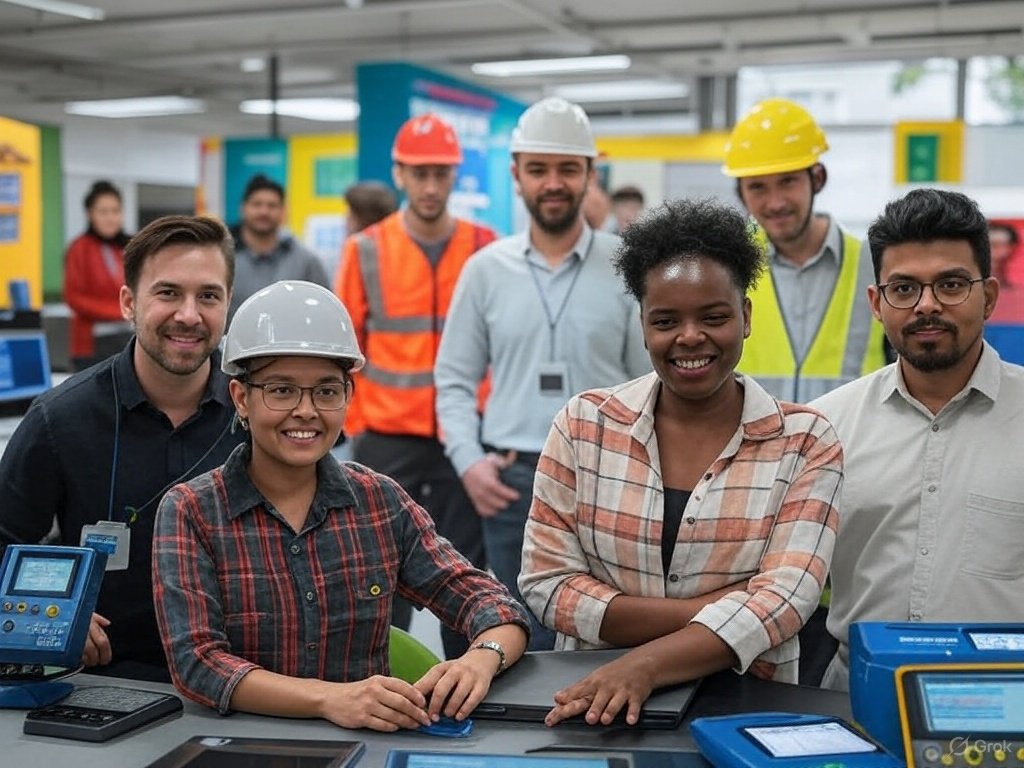AI in Warehousing: Boost Efficiency & Safety | Securade

In today's fast-paced and demanding logistics landscape, warehouse efficiency is paramount. Warehouses face a myriad of challenges, from inventory mismanagement and worker safety risks to operational delays and rising costs. These issues can significantly impact a company's bottom line and its ability to meet customer expectations. Traditional warehouse management systems often fall short in addressing these complexities, leading to bottlenecks and inefficiencies. This is where Artificial Intelligence (AI) steps in, offering transformative solutions that are reshaping warehouse operations and driving unprecedented levels of productivity and safety.
AI-powered industry solutions are not just a futuristic concept; they are a tangible reality that warehouses can leverage today to optimize their processes, reduce risks, and gain a competitive edge. By integrating AI technologies, warehouses can unlock new levels of automation, real-time monitoring, and data-driven decision-making, leading to significant improvements across the board. This blog post will delve into the ways AI is revolutionizing warehouse operations, focusing on specific pain points, real-world applications, and actionable strategies for implementation. We'll also highlight how Securade’s AI-powered platform is helping warehouses achieve remarkable results in efficiency and safety.
How AI is Transforming Warehouse Operations
AI is revolutionizing warehouse operations by automating tasks, providing real-time insights, and enabling data-driven decision-making. This transformation touches every aspect of the warehouse, from inventory management to worker safety and route optimization. Let's explore some key areas where AI is making a significant impact:
- Automation: AI-powered robots and automated systems are taking over repetitive and labor-intensive tasks, such as picking, packing, and sorting. This not only reduces the need for manual labor but also minimizes errors and speeds up the overall process.
- Real-Time Monitoring: AI algorithms can analyze video feeds from warehouse cameras and sensor data to provide real-time insights into operations. This includes monitoring worker movements, detecting safety hazards, and tracking inventory levels.
- Data-Driven Decisions: AI can analyze vast amounts of warehouse data to identify patterns, predict trends, and optimize processes. This enables warehouse managers to make informed decisions about inventory levels, staffing, and route planning.
- Predictive Maintenance: By analyzing data from warehouse equipment and machinery, AI can predict when maintenance is needed, reducing downtime and preventing costly repairs.
Key Pain Points in Warehousing Addressed by AI
Warehouses face numerous challenges that can hinder efficiency and increase risks. AI offers targeted solutions to address these pain points and create a safer, more productive environment. Here are some specific problems that AI can effectively solve:
- Forklift Accidents: Forklift accidents are a major concern in warehouses, leading to injuries, property damage, and increased insurance costs. AI-powered video analytics can detect unsafe forklift operation and alert workers to potential hazards.
- Misplaced Goods: Misplaced inventory can lead to delays, wasted time, and customer dissatisfaction. AI can track inventory in real-time and alert workers when items are not in their designated locations.
- Inefficient Workflows: Suboptimal warehouse layouts and inefficient workflows can slow down operations and increase costs. AI can analyze worker movements and identify bottlenecks, enabling warehouse managers to optimize workflows.
- Inventory Management: Balancing inventory levels to meet demand while minimizing storage costs is a constant challenge. AI can forecast demand and optimize inventory levels, reducing waste and improving customer satisfaction.
- Worker Fatigue: Repetitive tasks and long hours can lead to worker fatigue, increasing the risk of errors and accidents. AI-powered robots and automated systems can take over these tasks, freeing up workers to focus on more complex and engaging activities.
Securade’s AI-Powered Platform for Warehouses
Securade offers a comprehensive AI-powered platform designed to enhance warehouse safety, efficiency, and security. Our platform leverages state-of-the-art technologies, including video analytics, generative AI, and edge computing, to provide real-time insights and proactive solutions. Here's how our platform helps warehouses address their key challenges:
- Real-Time Hazard Detection: Our video analytics algorithms can detect a wide range of safety hazards, such as near misses, forklift violations, and unauthorized access. When a hazard is detected, the system instantly alerts workers and managers, allowing them to take corrective action and prevent accidents.
- Optimized Route Planning: Our platform analyzes worker movements and inventory locations to optimize routes for picking and packing. This reduces travel time, minimizes congestion, and improves overall efficiency.
- Enhanced Security: Our AI-powered surveillance system can detect suspicious activity and unauthorized access, protecting warehouse assets and preventing theft.
- Predictive Analytics: Our platform analyzes historical data to identify trends and predict future events, such as equipment failures and inventory shortages. This enables warehouse managers to take proactive steps to mitigate risks and optimize operations.
- Generative AI for Insights: Securade's platform uses generative AI to provide summaries of safety reports, incident investigations, and training materials. This speeds up the review process and provides staff with quick answers to critical questions.
Case Study: A Warehouse Boosting Efficiency with Securade
Let's consider a hypothetical scenario where a large distribution center implemented Securade's AI-powered platform. Prior to implementation, the warehouse faced challenges with worker safety, inefficient workflows, and high rates of product misplacement. After integrating Securade’s solutions, the warehouse experienced significant improvements across several key areas:
- Downtime Reduction: The distribution center reduced downtime by 20% due to proactive maintenance alerts and optimized workflows. The AI-powered platform predicted equipment failures, allowing maintenance teams to address issues before they caused major disruptions.
- Accident Reduction: The implementation of real-time hazard detection and safety alerts resulted in a 15% reduction in workplace accidents. Workers were immediately notified of potential dangers, such as forklift violations and near misses, enabling them to take corrective action.
- Inventory Accuracy: Inventory accuracy improved by 25% due to AI-powered tracking and optimized storage locations. The system alerted workers when items were misplaced, minimizing errors and improving order fulfillment rates.
- Improved Throughput: The warehouse experienced a 10% increase in overall throughput thanks to optimized routes and efficient workflows. AI analyzed worker movements and identified bottlenecks, allowing managers to streamline processes and improve productivity.
These results demonstrate the tangible benefits that AI can bring to warehouse operations. By addressing specific pain points and leveraging data-driven insights, warehouses can achieve remarkable improvements in efficiency, safety, and cost reduction.
Measurable Benefits for Warehouse Managers
Implementing AI in warehouse settings brings a host of measurable benefits that directly impact the bottom line and overall operational effectiveness. For warehouse managers, these advantages translate to:
- Lower Costs: AI-powered automation and optimization can significantly reduce operational costs by minimizing waste, preventing accidents, and improving resource utilization.
- Improved Throughput: Optimized workflows and efficient route planning lead to increased throughput, enabling warehouses to process more orders and meet customer demands more effectively.
- Safer Environments: Real-time hazard detection and safety alerts create a safer working environment, reducing the risk of accidents and injuries.
- Enhanced Security: AI-powered surveillance systems protect warehouse assets and prevent theft, minimizing losses and ensuring business continuity.
- Data-Driven Decision-Making: AI provides warehouse managers with valuable insights into operations, enabling them to make informed decisions and optimize processes based on real-time data.
Based on the case study, the warehouse manager also saw the following:
- 20% reduction in downtime, leading to less disruption and higher productivity.
- 15% decrease in workplace accidents, creating a safer and more reliable environment for employees.
- 25% improvement in inventory accuracy, reducing errors and enhancing customer satisfaction.
- 10% increase in overall throughput, enabling the warehouse to handle more orders and increase revenue.

Tips for Implementing AI in Warehouse Settings
Implementing AI in a warehouse environment can seem daunting, but with a strategic approach, the process can be smooth and effective. Here are some practical tips to guide you through the implementation process:
- Start with a Clear Strategy: Define your goals and objectives before implementing AI. Identify the specific pain points you want to address and the key performance indicators (KPIs) you want to improve.
- Integrate with Existing CCTV: Leverage your existing infrastructure by integrating AI-powered video analytics with your current CCTV system. This can save you time and money while still providing valuable insights.
- Train Your Staff: Provide adequate training to your staff on how to use and interpret the data generated by the AI system. This will ensure that they can effectively leverage the technology to improve their workflows.
- Start with High-Impact Areas: Focus on implementing AI in areas that will have the greatest impact on your warehouse operations. This could include safety, inventory management, or route optimization.
- Pilot Programs: Before fully deploying AI across your entire warehouse, start with pilot programs in specific areas. This will allow you to test the technology, gather feedback, and make adjustments as needed.
- Data Privacy and Security: Ensure that your AI implementation complies with all relevant data privacy and security regulations. Protect sensitive data and implement measures to prevent unauthorized access.
- Monitor and Optimize: Continuously monitor the performance of your AI system and make adjustments as needed to optimize its effectiveness. Regularly review your KPIs and track your progress towards your goals.
AI is transforming warehouse operations, offering unprecedented opportunities to enhance efficiency, safety, and security. By leveraging AI-powered solutions, warehouses can address their key pain points, optimize their processes, and gain a competitive edge. From real-time hazard detection to optimized route planning and predictive analytics, AI is revolutionizing the way warehouses operate and paving the way for a smarter, more efficient future.
Securade is at the forefront of this transformation, providing innovative AI-powered solutions that are helping warehouses achieve remarkable results. Our platform is designed to be flexible, scalable, and easy to implement, making it the ideal choice for warehouses of all sizes.
Ready to transform your warehouse operations? Star our GitHub project for updates and to join our community.